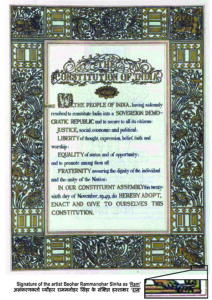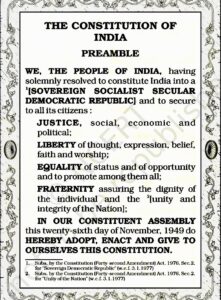INTRODUCTION
- Preamble serves as the introduction or preface to the constitution.
- It contains the Spirit or Essence of the constitution.
- It is referred as the Soul of Constitution.
- It establishes the main objective of Indian Constitution.
- It was Drafted & Moved by Pt. Jawaharlal Nehru on 13th dec 1946.
- It was enacted by constituent assembly but after the enactment of rest of the constitution.
COMPONENTS OF PREAMBLE
- Source of authority of constitution.
- Adoption date of constitution (26 Nov 1949).
- Nature of Indian State ( Sovereign , Socialist , Secular , Democratic , Republic )
- Objectives of Constitution ( Justice , Liberty , Equality , Fraternity ).
IMPORTANCE OF PREAMBLE
- It has been amended only once by 42nd constitutional amendment act (1976).
- Added 3 new words.
- Socialist, secular, integrity.
- Changed the words “unity of the nation” to “unity and integrity of the nation“.
- Key to Unravel the minds of makers.
- Include the ideals & desire of people of India.
- Contains enacting clause, brings constitution into force.
- It is Non – Justiciable cannot be enforced in court of law.
- Does not provide definite & real power nor limit the power of legislative, executive, judiciary.
- If any conflict arises between main prov. & Preamble. Main provision will prevail.
AMENDMENT IN PREAMBLE
In kesavananda bharti case 1973 it was held that the preamble can be amended under Article 368 , subject to the condition that no amendment is done to the basic structure .
Case laws
- Berubari case (1960)
It was held that preamble is not the part of constitution.
- Kesavananda bharti case (1973)
SC rejected its earlier opinion as expressed in Berubari case & held that “the preamble is a part of constitution”
- LIC of India case (1995)
SC again held that preamble is integral part of constitution. Preamble was enacted by constituent assembly but after the enactment of rest of the constitution
Reason for inserting the preamble at the end was to ensure that it was in conformity with the Constitution as adopted by the constituent assembly.
AMENDED BY WHOM & WHEN
The Preamble has been amended only once so far. On 18 December 1976, during the Emergency in India, the Indira Gandhi government pushed through several changes in the Forty-second Amendment of the constitution. A committee under the chairmanship of Sardar Swaran Singh recommended that this amendment be enacted after being consulted to study the question of amending the constitution in the light of past experience. Through this amendment, the words “socialist” and “secular” were added between the words “Sovereign” and “democratic” and the words “unity of the Nation” were changed to “unity and integrity of the Nation.
PREAMBLE BEFORE AMENDMENT

The Emergency
21-month period from 1975 to 1977 when Prime Minister Indira Gandhi had a state of emergency declared across the country. Officially issued by President Fakhruddin Ali Ahmed under Article 352 of the Constitution because of the prevailing “internal disturbance”, the Emergency was in effect from 25 June 1975 until its withdrawal on 21 March 1977. The order bestowed upon the Prime Minister the authority to rule by decree, allowing elections to be suspended and civil liberties to be curbed. For much of the Emergency, most of Indira Gandhi’s political opponents were imprisoned and the press was censored. Several other human rights violations were reported from the time, including a mass forced sterilization campaign spearheaded by Sanjay Gandhi, the Prime Minister’s son. The Emergency is one of the most controversial periods of independent India’s history
The final decision to impose an emergency was proposed by Indira Gandhi, agreed upon by the president of India, and thereafter ratified by the cabinet and the parliament (from July to August 1975), based on the rationale that there were imminent internal and external threats to the Indian state.
AMENDMENT OF THE PREAMBLE
B. R. Ambedkar, the principal architect of the Constitution, was opposed to declaring India’s social and economic structure in the Constitution. During the Constituent Assembly debates on framing the Constitution in 1946, K.T. Shah proposed an amendment seeking to declare India as a “Secular, Federal, Socialist” nation. In his opposition to the amendment, Ambedkar stated, “My objections, stated briefly are two. In the first place the Constitution… is merely a mechanism for the purpose of regulating the work of the various organs of the State. It is not a mechanism whereby particular members or particular parties are installed in office. What should be the policy of the State, how the Society should be organised in its social and economic side are matters which must be decided by the people themselves according to time and circumstances. It cannot be laid down in the Constitution itself, because that is destroying democracy altogether.
Ambedkar’s second objection was that the amendment was “purely superfluous” and “unnecessary”, as “socialist principles are already embodied in our Constitution” through Fundamental Rights and the Directive Principles of State Policy. Shah’s amendment failed to pass, and the Preamble remained unchanged until the 42nd Amendment.
PREAMBLE AFTER AMENDMENT



